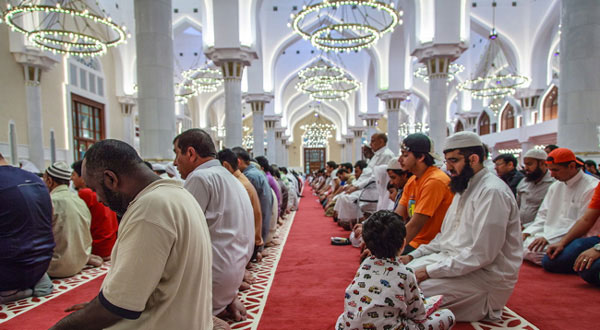Those who regularly pray the congregational fajr prayer know that on the first day of Ramadan the prayer shifts abruptly – by as much as three quarters of an hour (or even more) depending upon the time of the year – to an earlier time slot. And as soon as Ramadan ends it shifts again, this time moving forward by the same amount, allowing for the incremental adjustments to cater for the changing lengths of the day. Those who are accustomed to observing optional fasts (outside Ramadan) know that these shifts in the fajr prayer time have no bearing on imsak time (the moment when they must conclude their sahur). This can be a source of considerable confusion because there are those who have a hard time reconciling the inconsistent gaps between imsak and the call for prayer (azan) during Ramadan and during any other month.
One takes a big stride towards clearing this confusion the moment one understands that the azan and the imsak are two fundamentally distinct items. Imsak is the precise time when, in the words of the Quran, the white thread of dawn becomes distinct from the black thread (of night) – the so-called subh sadiq – and is listed in payer tables under the column entitled ‘fajr’. The fajr prayer can be performed soon after this time (allowing for the azan) but before sunrise. Inside this window, when exactly to conduct the prayer is an administrative and/or jurisprudential matter. During Ramadan, it stands to reason to make the azan and the imsak to coincide, with the congregational prayer typically commencing twenty or so minutes later. Because most people have been up for quite a while – for sahur if not longer still for tahajjud – so if there is a big gap between imsak and the fajr prayer, they may be tempted to go to sleep before performing fajr. What is more, in this case there is no confusion regarding imsak: one simply stops eating as soon as one hears the azan.
The association between the azan and the imsak is so deeply engraved in the layman’s consciousness that it is a safe bet that if the azan is not made to coincide with imsak, most people would continue eating till they hear the azan, thereby inadvertently invalidating their fast. Nothing is more illustrative of this persistent notion about the correlation between the two than the perpetual debate regarding whether it is permissible to eat and drink during the azan. A fascinating aside: An Abu-Dawood narration is usually pressed into service to prove the permissibility of finishing eating from the plate that is in one’s hand when one hears the azan. This narration has nothing whatsoever to do with Ramadan or even the fajr prayer. It is general advice for any prayer and makes all the sense in the world, for a hungry man is hardly in the right state of mind for the prayer, as is the man who needs to use the restroom. Hence the inadvisability of leaving one’s food and rushing to pray immediately upon hearing the azan, instead of finishing what is in one’s plate and then approaching the prayer so that one can concentration on it. If there are words that have the capacity to praise the wisdom of the Prophet (peace be upon him), at least I am unaware of them. With this admission, let me again pick up the thread of the discussion about the fajr timing where we left it in the last paragraph.
Once Ramadan is over, the situation could not be more different from that prevailing during the fasting month. Few are up at such an early hour; and the office and business hours being what they are, it is infinitely more convenient for people to be able to get sleep at a stretch before proceeding to their daily affairs, than being forced to sleep in two instalments. Outside Ramadan therefore, it makes a lot of sense to perform fajr later, which entails a corresponding delay in the azan. Since few are fasting, overstepping imsak time is not an overriding concern anymore.
As a similar administrative step, the congregational maghrib prayer in Ramadan is arranged to commence about fifteen minutes after the azan (again making use of the permissible window for the maghrib prayer) to enable people to reach the mosque in time after breaking their fasts. Outside Ramadan, the gap between the maghrib azan and the start of prayer is hardly five minutes.
These are commendable examples of administrative decisions (within the boundaries allowed by the Quran and Sunnat) aimed at public convenience. Any critics would be well within their rights to disagree with a particular administrative call, especially if they bring sound arguments to support their position. Administrative judgments are based on expected benefits to the public and almost always involve weighing of pros against cons. Man is notorious for erring in such matters; moreover, something that is deemed well-advised for a given time and place could easily leave much to be desired in another setting. The good thing about administrative judgments is that they can always be revised.
However, there have always been those too who, as a matter of policy, take an unfavourable view of any convenience when it comes to the religious domain. Which is unfortunate because it is patently contrary to the spirit of the famous prophetic narration according to which one should make matters easy, and not difficult, for people (within the elbow-space provided by Allah, of course). The Quran too, on multiple occasions, states explicitly that Allah merely intends to purify man, and not to burden him on account of his religion.






















